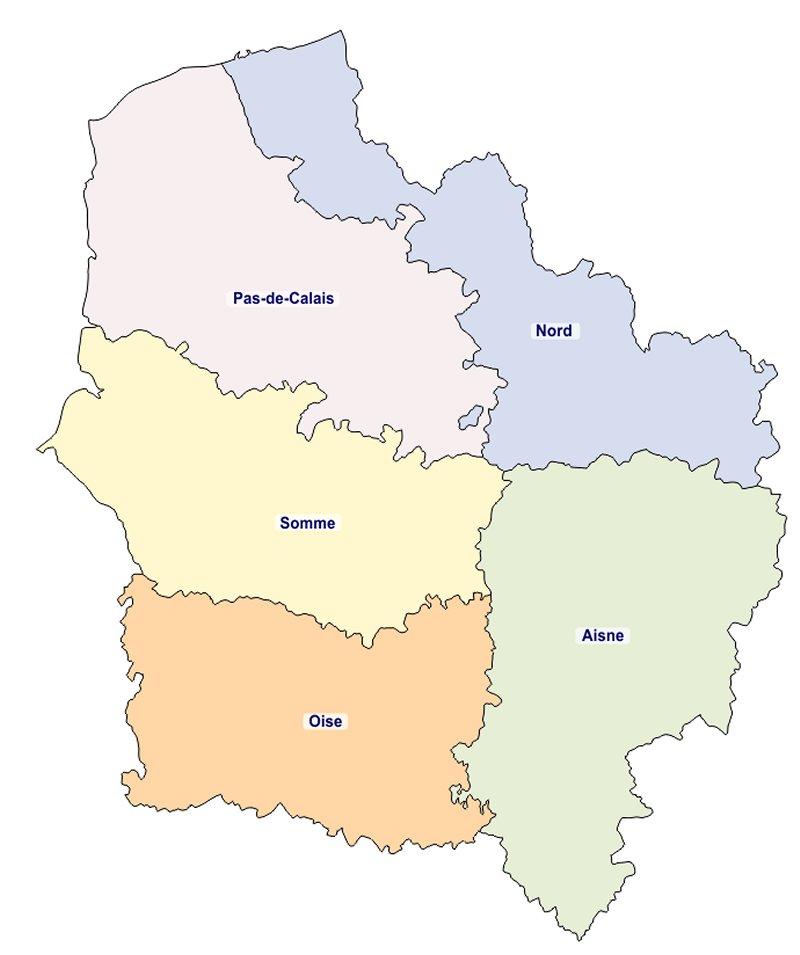
Like us on Facebook
PLACE NAMES


 |
|
Hauts-de-France
|

|
Hauts-de-France resulted from a compination of two existing regions of Northern France.
Nord-Pas de Calais, Nord for short, consisted of the departments of Nord and Pas-de-Calais, in the north and has a border with Belgium, and west with the UK. Most of the region was once part of the Southern Netherlands, within the Low Countries, and gradually became part of France between 1477 and 1678. The historical provinces now included in Nord-Pas-de-Calais are Artois, Boulonnais, Calaisis, Cambraisis, French Flanders, French Hainaut and portions of northern Picardy, and the regional nickname Bassin Minier or Meiners-Bassen (Miners' or Mining Basin in the region's two languages) derived from historically large mining deposits. These provincial designations are still frequently used by the inhabitants, which offers a sense of civic pride.
With its 330.8 people per km² on just over 12,414 km², it is a densely populated region, having some 4.1 million inhabitants, or seven percent of France's total population, making it the fourth most populous region in the country - 83% of whom live in urban communities. Its administrative centre and largest city is Lille. The second largest city is Calais, which serves as a major continental economic/transportation hub with Dover of Great Britain 42 kilometres (26 mi) away; the White Cliffs of Dover are visible from Calais on a clear day. Other major towns include Valenciennes, Lens, Douai, Béthune, Dunkirk, Maubeuge, Boulogne, Arras, Cambrai and Saint-Omer.
The name Nord-Pas-de-Calais combines the names of the constituent departments of Nord (literally 'North', the northernmost department of France) and Pas-de-Calais ('Strait of Calais', the French name of the Strait of Dover). Since 2016, Nord-Pas-deCalais and Picardie have been combined into a single region named Hauts-de-France.Picardy (French: Picardie) now forms the southern part of the Hauts-de-France Region since 2016.
The historical province of Picardy stretched from north of Noyon to Calais, via the whole of the Somme department and the north of the Aisne department. The province of Artois (Arras area) separated Picardy from French Flanders.
Picardy stretches from the long sand beaches of the Somme estuary in the west to the vast forests and pastures of the Thiérache in the east and down to the chateaux of Chantilly or Pierrefonds near the Paris Area and vineyards of the border with Champagne (Champagne picarde) to the south.
Picardy is the birthplace of Gothic architecture, housing six of the world's greatest examples of Gothic cathedrals, which envelop the history of Gothic architecture in its entirety. Amiens Cathedral, standing as the largest cathedral in Europe, which according to John Ruskin is the "Pantheon of Gothic architecture", could house the Notre-Dame de Paris twice over. It was built in as little as 50 years. Picardy also holds the tallest transept in the history of the Gothic period located on Saint-Pierre cathedral in Beauvais, Oise.
The Museum of Picardy, built between 1855 and 1867, houses a vast array of great works, spanning centuries. Archaeology from ancient Greece and Egypt to works of Pablo Picasso. The museum was built for the very reason it is used today. Although Picardy is one of the least known regions in France, its influence from art and most certainly architecture is vivid throughout the world.
In short, it is an area of surprises. Turn almost any corner and something pleasant greets you.
 Feel free to Email me any additions or corrections Feel free to Email me any additions or corrections
LINKS AVAILABLE TO YOUR SITE
| | | |





